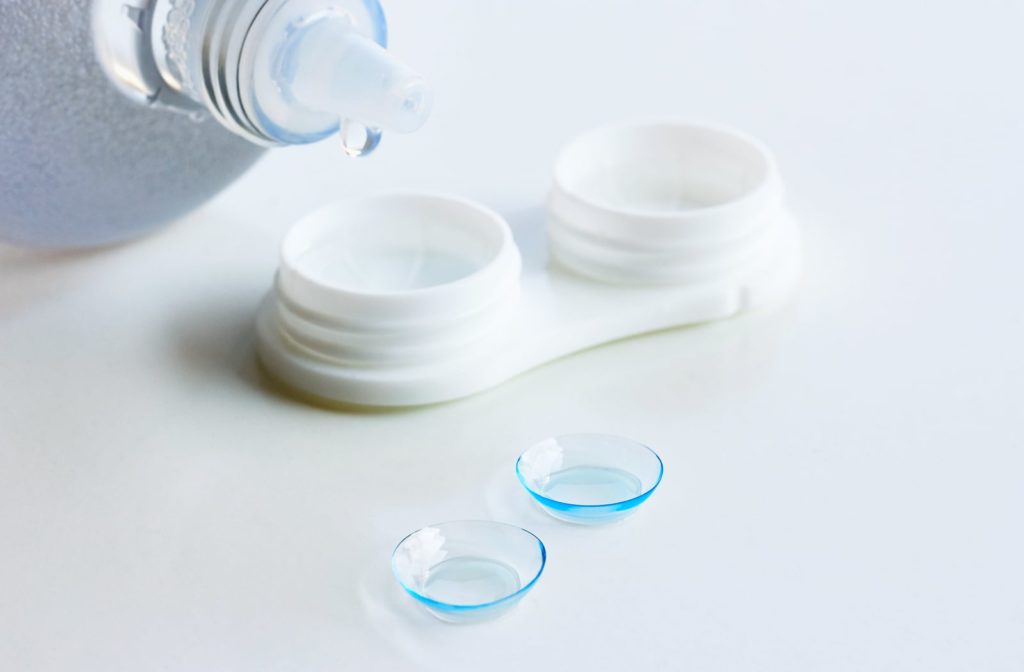Switching between contact lenses and glasses is a convenient luxury you can enjoy with vision care. Proper maintenance is a part of both contact lenses and glasses, and it’s essential to practice good habits when storing your contact lenses.
Let’s take a closer look at contact lenses, including proper maintenance and how to store them.
What to Expect With Contact Lenses
Glasses have always been a great way to correct your vision and customize your look, but sometimes you want a change, and contact lenses can provide a different look.
Contact lenses are an excellent choice for people with vision correction needs, such as correcting refractive errors.
Refractive errors include vision disorders such as:
- Nearsightedness (myopia)
- Farsightedness (hyperopia)
- Astigmatism
- Presbyopia
Contact lenses provide flexibility and convenience and come in various lenses to deal with these refractive errors.
The first step in getting your contact lenses is a comprehensive contact lens exam. This exam is done to check if any eye conditions will prevent you from wearing contact lenses comfortably.
Some of these preventative eye conditions include:
- Dry eyes
- Keratoconus
- Eye infections
- Eye diseases
After your contact lens exam, your optometrist will then determine what type of contact lenses are best for your eyes. Your optometrist will measure the size of your pupil and the shape of your eye to assess the quality of your tear film.
Let’s look at some different types of contact lenses that may be right for you.
Rigid Gas-Permeable (RGP) Contact Lenses
Rigid gas-permeable lenses are made of durable plastics and allow oxygen to pass through the lens. These lenses can be helpful if soft contact lenses haven’t done the trick or you’re dealing with dry eyes.
RGP lenses are more durable than soft contact lenses and must be removed for cleaning and disinfection every night. The adjustment period for RGP lenses can vary, but they are great for long-term wear.
Bifocal & Multifocal Contact Lenses
Bifocal and multifocal contact lenses are designed to allow clear vision at all distances for people dealing with refractive errors. These lenses are also great for people experiencing presbyopia.
Bifocal and multifocal lenses are available in both soft materials and rigid gas-permeable materials. You can wear them on a disposable basis or opt for more permanent lenses.
Toric Lenses
Toric contact lenses are designed to combat astigmatism, a refractive error caused by a misshapen cornea. Toric lenses are soft contact lenses that are usually made of either hydrogel or silicone hydrogel. These materials allow for more oxygen to pass through to your eyes.
Every eye dealing with astigmatism is unique and has a unique shape, size, and different conditions, so finding the right lens can involve trial and error.
Scleral Lenses
Scleral contacts are large-diameter gas-permeable contact lenses designed to cover the entire corneal surface and rest of the sclera. Scleral contacts can morph an irregular cornea into a smooth optical surface.
Scleral contacts are gas-permeable, allowing oxygen to reach the eye’s surface, resulting in more breathability for your eye. Because of this breathability, these contact lenses are an excellent option for dealing with dry eye disease.
Now that you know some of the different types of contact lenses—let’s look at proper maintenance and how to store your contact lenses.

Storing Your Contact Lenses
Taking care of your contact lenses and practicing proper maintenance are essential. Not doing so can result in serious eye infections or other eye conditions.
The first step to storing your contact lenses properly is following the instructions laid out by your optometrist about wearing and replacing your lenses. It’s crucial to remain consistent with the instructions given with your contact lens prescription.
The next step is practicing good cleaning methods.
Some general tips to follow:
- Wash your hands with soap and water and dry them with a lint-free towel before handling your contact lenses.
- Never put contacts in your mouth to wet them—saliva is not a sterile solution.
- Do not rinse or store contacts in water and use your prescribed solution.
- Do not use a homemade solution.
- Use a new solution round each time you clean and disinfect your contact lenses.
Following the cleaning process, you can shift your attention to the case to prepare it for proper storage.
It’s crucial to keep your contact lens case clean by rinsing it with your sterile contact lens solution and avoiding tap water. Following the rinsing, leave the empty case open to air dry. Finally, replacing your contact lens case at least every 3 months is a great idea. Keeping an eye on any cracks or damage is also recommended.
Contact lenses are delicate, and when handling them, you should take all necessary precautions.
Contact Lens Safety
Switching up your look is always fun, and rotating between contact lenses and glasses offers a ton of customization. Proper care for your contact lenses means cleaning them properly and replacing them when needed to wear them safely.
Book an appointment with your optometrist today for more information on contact lenses and find the right type of lens for you.



